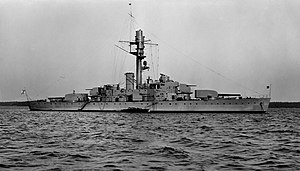Finnish coastal defence ship Väinämöinen

Väinämöinen in 1938
|
|
| History | |
|---|---|
|
|
|
| Name: | Väinämöinen |
| Namesake: | Väinämöinen |
| Ordered: | 1927 |
| Builder: | Ab Crichton-Vulcan Oy |
| Laid down: | August 1929 |
| Launched: | 29 April 1932 |
| Commissioned: | 28 December 1932 |
| Fate: | Transferred to Soviet Union 29 May 1947 |
|
|
|
| Name: | Vyborg |
| Acquired: | 29 May 1947 |
| Fate: | Scrapped ca 1966 |
| General characteristics | |
| Class and type: | Väinämöinen-class coastal defence ship |
| Displacement: | 3,900 t |
| Length: | 93.0 m (305.1 ft) |
| Beam: | 16.864 m (55.33 ft) |
| Draught: | 5.0 m (16.4 ft) |
| Propulsion: |
|
| Speed: | 14.5 knots (26.9 km/h; 16.7 mph) |
| Range: | 700 nmi (1,300 km; 810 mi) |
| Complement: | 410 |
| Armament: | |
Väinämöinen was a Finnish coastal defence ship, the sister ship of the Finnish Navy's flagship Ilmarinen and also the first ship of her class. She was built at the Crichton-Vulcan shipyard in Turku and was launched in 1932. Following the end of the Continuation War, Väinämöinen was handed over to the Soviet Union as war reparations and renamed Vyborg. The ship remained in Soviet hands until her scrapping in 1966.
Väinämöinen and Ilmarinen were planned to be mobile coastal fortresses for the defence of the Finnish demilitarized islands at Åland in particular. The two ships were not well suited for the open seas due to a design with emphasis on operations in the shallow waters of the archipelago: it has been said that they were volatile and rolled too much. The minimal depth keel, together with the high conning tower, made the ships' movements slow and wide. It was said that the ships were uncomfortable, but harmless to their crews.
The ship's heavy armament of 254-millimetre (10 in) Bofors guns could fire shells of 255 kilograms (562 lb) up to 31 kilometres (19 mi).
In fire control, the two coastal ships were identical. The fire control centre and the gun towers were connected electrically so that ranging and orders could be given without spoken contact. With the aid of mechanical calculators, the values were transferred directly to the gun towers.
During the Winter War, the two coastal defence ships were transferred to the Åland islands to protect against invasion. When the ice cover started to become too thick in December, the ships were transferred to Turku, where their anti-aircraft artillery aided in the defence of the city.
The only time Väinämöinen and Ilmarinen fired their heavy artillery against an enemy was at the beginning of the Continuation War, during the Soviet Red Army evacuation of their base at the Hanko Peninsula. Väinämöinen also participated in the distraction manoeuvre Operation Nordwind on 13 September 1941, during the course of which her sister ship Ilmarinen was lost to mines.
...
Wikipedia
